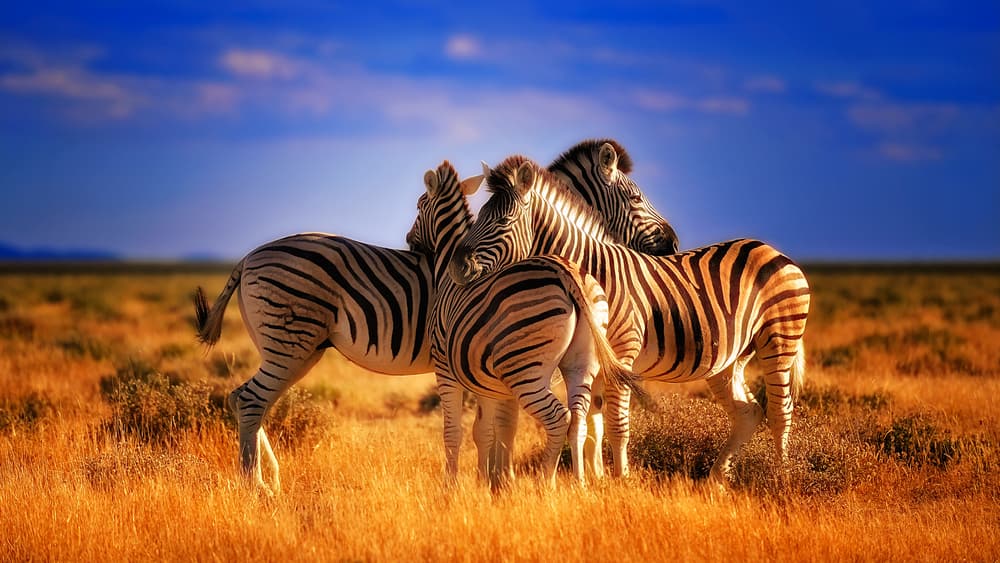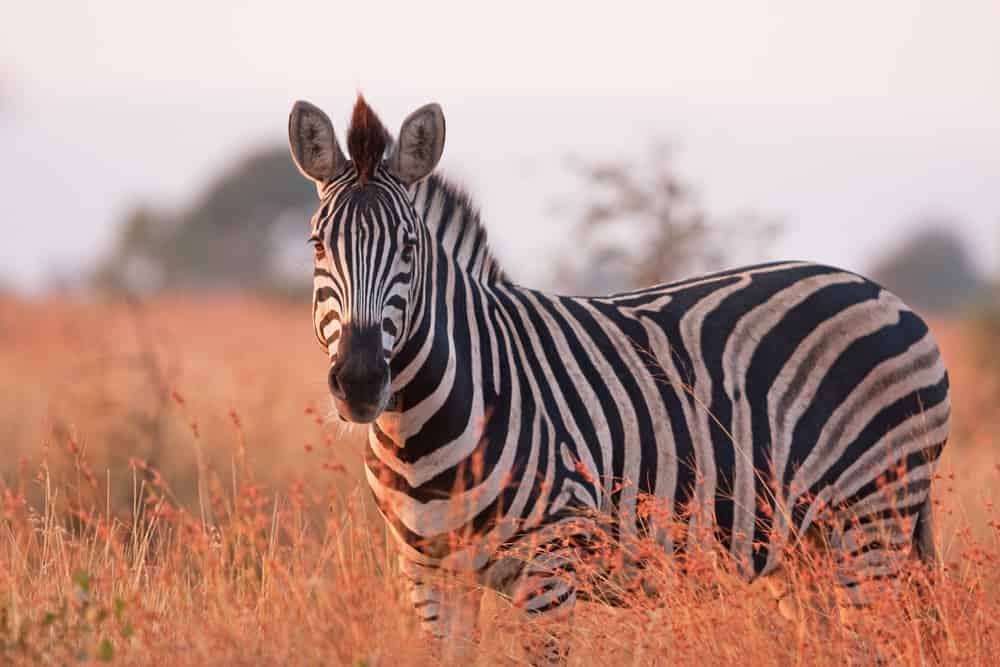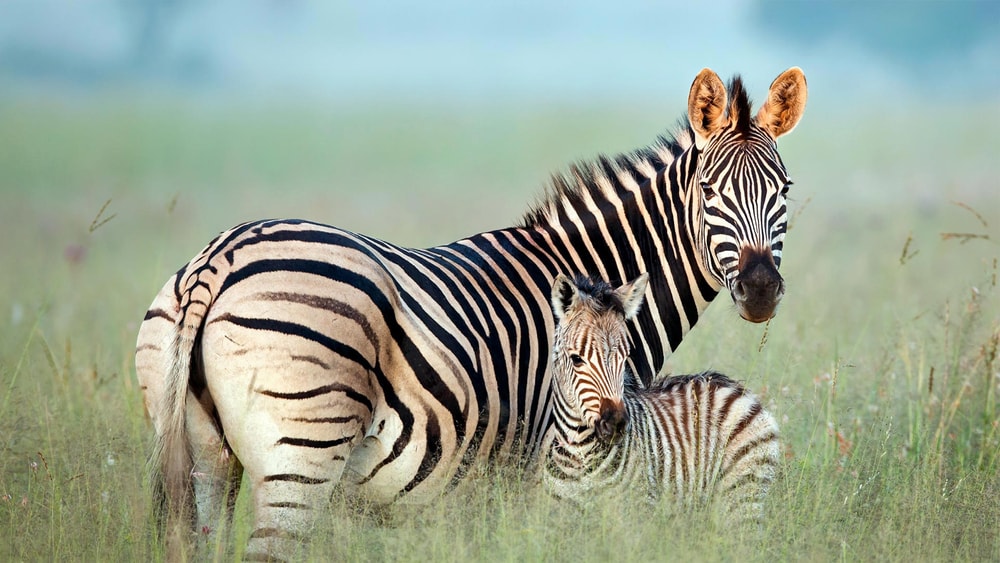
Beyond their aesthetic appeal, the iconic stripes of a zebra might serve crucial evolutionary and survival purposes.
©Shllabadibum Bubidibam/Shutterstock.com
Have you ever caught yourself lost in the dance of a zebra’s stripes, wondering about the story behind those stark black-and-white patterns? You’re in good company. For years, the zebra’s distinctive coat has been a subject of intrigue for scientists, wildlife enthusiasts, and even the casual onlooker.
Let’s take a closer look at why zebras have such remarkable stripes.
Theories Behind the Design
The zebra, an emblematic resident of the African plains, has long captured human imagination. Its stripes, akin to nature’s own QR code, are distinct for every individual.
However, the burning question remains: Why stripes? Why not a splash of spots or a cascade of waves?
Camouflage: The Art of Deception in Zebras
At first glance, the zebra’s black and white stripes might seem like a mishap in the golden hues of the African savannah. But nature is a master of deception. Rather than aiming for invisibility, the zebra’s stripes create a mesmerizing optical illusion. Imagine being a lion, hungry, and on the prowl.
How?
As a herd of zebras gallop, their stripes blur into a dizzying dance of light and shadow. This phenomenon, known as ‘motion dazzle,’ confounds the predator’s vision. This makes it nearly impossible to single out and target one individual zebra from the herd. It’s nature’s version of a magic trick, and the zebra is the star performer.
Social Bonds: The Zebras Stripe ID
Imagine walking into a crowded room and trying to spot a friend. You’d look for that familiar hairstyle or maybe their favorite jacket, right? Well, for zebras, it’s kind of the same, but with stripes.
Out in the African plains, each zebra has its own unique set of stripes, kind of like our fingerprints. They don’t just wear them for style; these stripes help them recognize their buddies, family, and even those they might not get along with. So, when you see a zebra’s stripes, remember it’s not just a pretty pattern—it’s their way of saying, “Hey, I know you!”
Nature’s AC: The Zebras Temperature Control Theory
Surviving under the blazing African sun requires some ingenious adaptations. Zebras might have a built-in cooling system, thanks to their stripes. The theory suggests that the black stripes, absorbing more sunlight, heat up faster than the white ones.
How could this work?
The temperature difference between stripes could create micro air currents, cooling the zebra’s skin. It’s a subtle, yet natural and effective air conditioning system, helping the zebra helping zebras stay comfortable even in the harshest heat.
Stripes to the Rescue: Zebras Fending Off Pests
A day ruined by pesky flies is a familiar annoyance for many of us. Zebras, however, might have a natural solution to this problem. Their contrasting stripes could act as a repellent for blood-sucking pests like tsetse flies. The sharp black-and-white contrast might disorient these insects. This makes it difficult for them to land and bite. It’s a brilliant strategy, ensuring the zebra enjoys a relatively pest-free existence.
Nature’s Healing Touch
Here’s a theory that adds another layer to the marvel of zebra stripes: they might have healing properties. Some observations have indicated that wounds on striped areas of a zebra’s body tend to heal faster than those on non-striped regions.
Could the stripes possess antimicrobial properties that help fend off infections? If true, it’s akin to nature gifting the zebra its protective band-aid. As a result, zebras enjoy a quick recovery, minimizing the risk of complications.

When you look closely at a zebra’s skin, you can truly appreciate the intricate patterns and designs of nature.
©Chantal de Bruijne/Shutterstock.com
Different Zebra Species and Their Stripes
Zebras, the black-and-white wonders of the African landscape, are far more diverse than they might first appear. When you delve into the world of zebras, you’ll find that their stripes tell tales of evolution, adaptation, and individuality. Let’s embark on a journey through the three primary species:
Plains Zebra
The Plains Zebra, often seen grazing the expansive African grasslands, is the most commonly encountered species. Their stripes are a masterpiece of nature, broad and curvaceous, running vertically down their backs and transitioning to horizontal patterns on their legs.
Here’s a tidbit to share at your next gathering: No two Plains Zebras have the same stripe pattern, much like human fingerprints!
Mountain Zebra
These zebras have a penchant for the rugged terrains of mountainous regions. Their most distinguishing feature is their immaculate white belly. The belly stands in sharp contrast to their narrower, more uniform stripes. Unlike the whimsical patterns of the Plains Zebra, the Mountain Zebra’s stripes are more predictable and straight-edged.
Grevy’s Zebra
Think of the Grevy’s Zebra as the high-fashion model of the zebra world. They boast the sleekest, most closely packed stripes, which extend seamlessly to their white underbellies. Notably, they’re also the largest of the zebra species, bearing a closer resemblance to wild horses than to their zebra kin.
The diverse stripe patterns across these species are a subject of fascination. Could it be that the Mountain Zebra’s regular stripes help camouflage them in their rocky environments? Or perhaps the Grevy’s compact stripes are an adaptation to their dry, desert-like habitats? The mysteries abound!

When you observe a herd of zebras together, the collective pattern of their stripes creates a genuinely mesmerizing visual effect.
©Puspok/Shutterstock.com
Cultural Impact of Zebra Stripes
The mesmerizing stripes of the zebra, a masterpiece of nature’s design, have always been a source of wonder and intrigue. While these patterns play a pivotal role in the survival and social dynamics of these magnificent creatures in the wild, their influence doesn’t stop there. The zebra’s iconic stripes have galloped beyond the African plains. These stripes weave into the fabric of human culture and expression.
Zebras Fashion
Zebra prints have galloped from the wild terrains of Africa to the bustling streets of global fashion capitals. Their bold, contrasting patterns have become a favorite among designers and fashion enthusiasts alike. From the runways showcasing haute couture evening gowns to local boutiques offering chic handbags and shoes, the zebra print is everywhere.
Even interior designers have embraced this trend, incorporating zebra motifs in rugs, cushions, and wall art. As a result, the timeless appeal of these stripes ensures they remain a symbol of wild sophistication in the fashion world.
Art Featuring Zebras
The zebra’s mesmerizing design has inspired countless artists over the years. From painters capturing their majestic stances in abstract forms to sculptors molding their essence in three-dimensional art, the zebra has been a muse for many. Art exhibitions and galleries worldwide often feature pieces that pay homage to this magnificent creature, highlighting its beauty and the mysteries it embodies.
Symbolism of Zebras
Beyond aesthetics, the zebra’s stripes hold profound symbolic meaning. In many cultures, the zebra’s balanced black-and-white design symbolizes harmony, unity, and the interconnectedness of opposites. It’s a powerful emblem of the yin and yang. Zebras remind us of the delicate equilibrium that exists in nature and life. For many, the zebra serves as a symbol of peace, unity, and the importance of finding balance amidst life’s challenges.
In short, the zebra’s stripes, while a marvel in the natural world, have also deeply resonated with humanity, influencing our art, fashion, and philosophies. Their enduring appeal is a testament to the timeless beauty and profound symbolism they embody.

The unique and mysterious nature of zebra stripes continues to be a topic of fascination for both scientists and nature enthusiasts.
©Martin Prochazkacz/Shutterstock.com
Zebras Conservation Efforts
The future of these magnificent striped creatures is uncertain. With challenges like habitat loss, poaching, and the unpredictable impacts of climate change, some zebra species teeter on the brink of extinction.
Champions like the African Wildlife Foundation and the World Wildlife Fund are on the front lines, ensuring zebras get the chance they deserve. Their mission goes beyond just saving land or curbing hunting. It’s about shifting perspectives. By partnering with local communities, they’re spotlighting the true essence of zebras – not just as resources, but as awe-inspiring creatures that make our world more magical.
In short, as individuals who appreciate the beauty and wonder of zebras in their many forms and stripes, we must lend our support to these endeavors. This ensures that the legacy of the zebra, with its captivating stripes, continues to inspire future generations.

Observing a young zebra foal, you’ll notice its stripes aren’t as defined, hinting at the evolutionary progression and importance of these markings.
©Shllabadibum Bubidibam/Shutterstock.com
Why Stripes? The Saga Continues for Zebras
Several theories for zebra stripes have been proposed over the years. Some scientists believe that the stripes act as camouflage, helping zebras blend into the tall grasses of the African savannah, making it harder for predators to single out an individual.
Others suggest that the stripes might play a role in temperature regulation, with the alternating black and white patterns helping to dissipate heat.
Yet another fascinating hypothesis is that the stripes deter biting flies, which seem to be less attracted to striped surfaces.
But here’s the thing: while each of these theories holds water and is backed by some evidence, none have been universally accepted as the definitive answer. And every time we think we’re close to solving the riddle, a new piece of information or a fresh perspective emerges. This inevitably sends researchers back to the drawing board.
And maybe, just maybe, that’s what makes zebras so enchanting. In an age where we often feel we have all the answers at our fingertips, zebras remind us of the thrill of the unknown. They stand as a testament to the fact that nature, in its grandeur, continues to mystify us.
The ongoing saga of the zebra stripes is more than just a scientific conundrum; it’s a poetic reminder of the wonders that still exist in our world. They’re still waiting to be explored. In the end, zebras beckon us to approach nature with humility, curiosity, and a sense of awe, cherishing the mysteries that remain and the endless possibilities they represent!
Thank you for reading! Have some feedback for us? Contact the AZ Animals editorial team.







